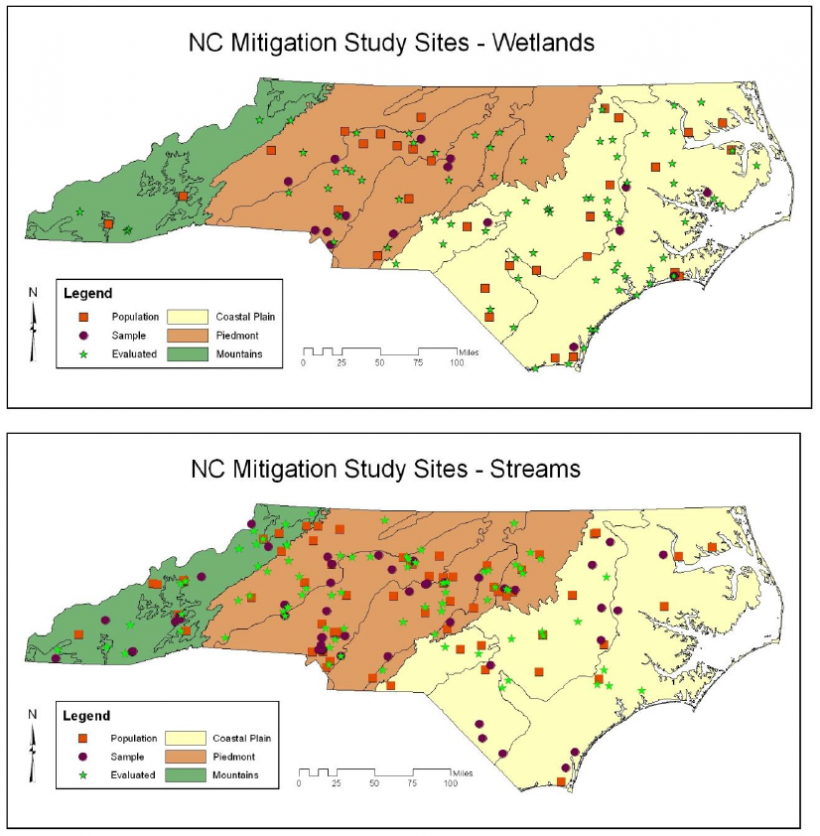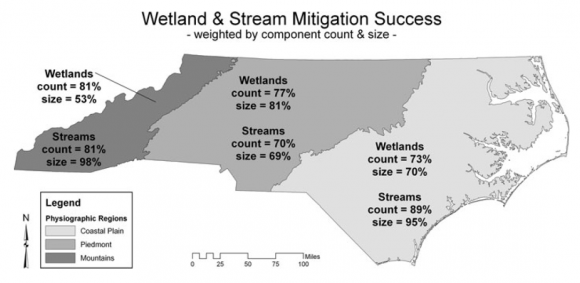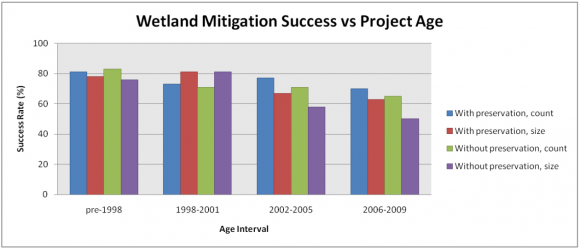 From across North Carolina (NC), data from a probability sample were used to estimate wetland and stream mitigation success for projects deemed successful in the years 2007-2009. “Success” was defined as whether a mitigation site met regulatory requirements that were in place at the time of construction. These regulatory success criteria in NC for wetlands included hydrology (continuous saturation during a certain part of the growing season), vegetation (surviving planted woody stem density), soils (one hydric soil indicator, although soils were very rarely used as success criteria), and protection (long-term land protection). Regulatory success criteria for stream mitigation constructed before 1999 included non-quantitative measures of stable cross-sections and some percentage of survival of planted vegetation. Later projects required certain geomorphic features (pool/riffle spacing, pebble counts, etc.), survival of planted stems, and reconnection with stream floodplains.
From across North Carolina (NC), data from a probability sample were used to estimate wetland and stream mitigation success for projects deemed successful in the years 2007-2009. “Success” was defined as whether a mitigation site met regulatory requirements that were in place at the time of construction. These regulatory success criteria in NC for wetlands included hydrology (continuous saturation during a certain part of the growing season), vegetation (surviving planted woody stem density), soils (one hydric soil indicator, although soils were very rarely used as success criteria), and protection (long-term land protection). Regulatory success criteria for stream mitigation constructed before 1999 included non-quantitative measures of stable cross-sections and some percentage of survival of planted vegetation. Later projects required certain geomorphic features (pool/riffle spacing, pebble counts, etc.), survival of planted stems, and reconnection with stream floodplains.
Analytical results were weighted by both component counts and mitigation size. Overall mitigation success (including preservation) was estimated at 74 % (+/- 3 %) for wetlands and 75 % (+/- 4 %) for streams in NC. Compared to the results of previous studies, wetland mitigation success rates had increased since the mid-1990s. Differences between mitigation providers were generally not significant although permittee-responsible mitigation yielded higher success rates in certain circumstances. Mitigation providers included mitigation banks, NC Ecosystem Enhancement Program’s design-bid-build and full-delivery programs (now called Division of Mitigation Services), NC Department of Transportation and private permittee-responsible mitigation. Both wetland and stream preservation showed high rates of success and the stream enhancement success rate was significantly higher than that of stream restoration.

Additional statistically significant differences when mitigation size was considered included: (1) the Piedmont yielded a lower stream mitigation success rate than other areas of the state, and (2) wetland mitigation projects constructed 2002-2009 demonstrated a lower success rate than those built prior to 2002. Opportunities for improvement exist in the areas of regulatory record-keeping, understanding the relationship between post-construction establishment and long-term ecological trajectories of stream and wetland restoration projects, incorporation of numeric ecological metrics into mitigation monitoring and success criteria, and adaptation of stream mitigation designs to achieve greater success in the Piedmont.

Mitigation is a way of making up for losses in wetland and stream functions when areas are developed.
This work was funded under EPA Wetland Program Development Grant Cooperative Agreement WL-9643505

